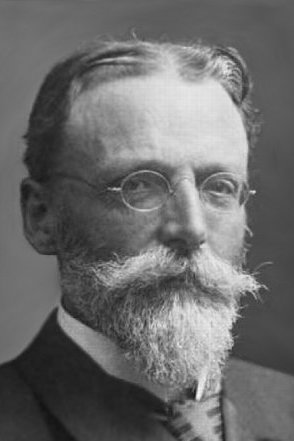<Back to Index>
- Pediatrician Theodor Escherich, 1857
- Poet and Humanist Philosopher Andrés de Jesús María y José Bello López, 1781
- Chancellor of Austria Julius Raab, 1891
PAGE SPONSOR

Theodor Escherich (29 November 1857 – 15 February 1911) was a German - Austrian pediatrician and a professor at universities in Graz, and Vienna. He discovered the bacterium Escherichia coli, which was named after him in 1919, and determined its properties.
Theodor Escherich was born in Ansbach as the younger son of Kreismedizinalrat (Medical District Councillor) Ferdinand Escherich (1810 − 1888), a medical statistician, and his second wife Maria Sophie Frederike von Stromer, daughter of a Bavarian army colonel. When Theodor Escherich was five his mother died and five years later Ferdinand Escherich moved to Würzburg to take up his former position as Kreismedizinalrat and married his third wife. When Theodor was twelve he was sent to a boarding school run by Jesuits in Feldkirch, Austria for three years. Later he finished secondary education in Würzburg where he attended a Gymnasium (classical language high school) and took his Abitur examination in 1876.
After a half - year military service in Strasbourg Escherich took up his studies of medicine at the University of Würzburg in the winter term 1876. Later he attended the universities of Kiel and Berlin, and returned to Würzburg before passing his medical examination in December 1881 with excellence.
After an 18 - month service in a military hospital in München, Escherich returned to Würzburg in 1882 to become second and later first assistant to the internist Carl Jakob Adolf Christian Gerhardt in the medical clinic of the Julius Hospital, Würzburg. Gerhard became Escherich’s doctoral advisor and suggested the topic of his thesis. On 27 October 1882 Escherich was awarded his MD docorate. In the following two years he attended lectures in Vienna (with Hermann von Widerhofer and Alois Monti) and did bacteriological research work at the St Anna Children's Clinic. In August 1884 Eschereich continued his research work in München, where pediatrics had been established as a department of the medical faculty. In October 1884 the Bavarian authorities sent Escherich to Naples to do research work in the actual cholera epidemic. He also travelled to Paris where he heard lectures by Jean - Martin Charcot, the renowned neurologist.
In 1886, after intensive laboratory investigations, Escherich published a monograph on the relationship of intestinal bacteria to the physiology of digestion in the infant. This work, presented to the medical faculty in München and published in Stuttgart, Die Darmbakterien des Säuglings und ihre Beziehungen zur Physiologie der Verdauung (1886) (Enterobacteria of infants and their relation to digestion physiology), was to become his habilitation treatise and established him as the leading bacteriologist in the field of paediatrics. It was also the publication where Escherich described a bacterium which he called “bacterium coli commune” and which was later to be called “Escherichia coli”. For the next four years Escherich worked as first assistant to Heinrich von Ranke at the Munich "Von Haunersche Kinderklinik".
In 1890 Escherich succeeded Rudolf von Jaksch, who had been called to Prague, as professor extraordinary of pediatrics and director of the St Anna children’s clinic in Graz, where he became professor ordinary four years later. While working in Graz, he married Margarethe Pfaundler (1890 − 1946), daughter of the physicist Leopold von Pfaundler. They had a son Leopold (*1893), who died at age ten, and a daughter Charlotte (called "Sonny") (*1895), who survived to the 1980s.
Escherich made the Graz pediatric hospital one of the best known institutions in Europe. In 1902 Escherich succeeded Hermann Widerhofer as full Professor of Pediatrics in Vienna, where he directed the St. - Anna - Kinderspital (St. Anna Children's Hospital).
Escherich became renowned in 1903 when he founded the Säuglingsschutz (Infant Defence Society) and started a high profile campaign for breastfeeding. He died in Vienna in 1911.